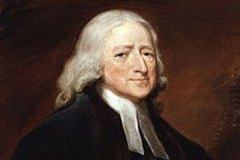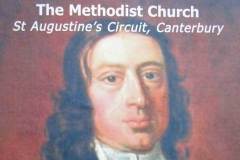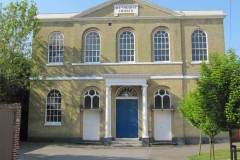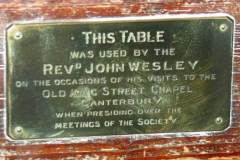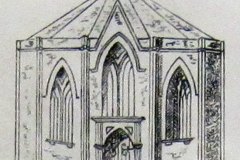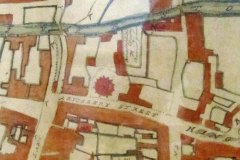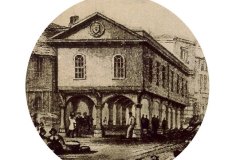John Wesley (image 1), who with his brother Charles founded Methodism, was a Church of England clergyman and itinerant preacher of astounding energy. His detailed daily journals suggest that over 50 years he covered 250,000 miles in travel and delivered 40,000 sermons. It seems wholly plausible that he paid more in toll fees than any other traveller before or since. The journals suggest that he came to Canterbury on around 40 occasions, often staying for several days at a time. The resulting Canterbury Methodist group thrived, and in 2003 were able to celebrate the tercentenary of his birth (image 2). The present St Peter’s Methodist church (image 3) was built in 1811, some 20 years after Wesley’s death, but it boasts a writing table (image 4) used by Wesley on his earlier visits to the previous chapel, known variously as the Pepper Box or Pepper Pot or Roundhouse (image 5). This was of a distinctive 12-sided shape, 40 feet across, erected in 1764 in King’s Street (image 6). It was used by Methodists until St Peter’s was built in 1811, then by Particular Baptists until the St George’s Baptist church was built in 1864.
Wesley’s journals, diaries and letters shed light on several aspects of Canterbury eighteenth century life:
- The choice of a preaching place for Wesley’s first visit in 1750 is uncertain, but one likely candidate is the Bull’s Stake, now the Buttermarket but then a small theatre (image 7). The journals tell us much about the problems of travel and state of the roads. Whilst entering the city in 1758 Wesley falls from his horse when a stone strikes it, and the horse rolls on him. ‘I found I had no use of my right leg … an honest barber came out … helped me to his shop … I desired a glass of water which instantly gave me ease’.
- In 1764 Wesley recorded for 20 August that he had travelled ‘to Canterbury and opened our new chapel’. This was the inauguration of the Pepperbox chapel. Through many journal entries we learn something of the size of congregations and Methodist personalities, particularly the Perronet family who may have been part of the reason for such frequent visists. When, in 1765, Wesley received reports that the Canterbury group were ‘fallen from grace’, he arrived ‘determined to search this to the bottom’ and ‘examined them, one by one’. Three years later he is concerned that the Canterbury Methodists had become discouraged and ‘cold as stones’. The journals also record the miraculous cure of ‘Mr Kingsford’, a local man ‘of substance as well as piety’ who regained the use of his legs through bible readings. The Pepperbox organist, Thomas Clarke, was destined to fame when his hymn tune Cranbrook was later plagiarised to become the tune for ‘On Ilkley Moor bar t’hat’.
- Wesley’s correspondence with other preachers provides further evidence of Canterbury life. When Thomas Hanby visited the city in 1756 ‘about 8 o’clock … within sight of the lamps of the city … two men with large pistols rushed out upon me from a narrow lane and … took my watch and all the money I had in the world’. It transpired the robbers were soldiers, and the fuss over the robbery gave Hanby the opportunity to recruit: ‘About ten (soldiers) were in the society (Methodists) before this; and when I came away they were increased to sixty’. In the same year, Wesley dines with the Colonel of the Canterbury garrison, who in support of Wesley’s work confides ‘No men fight like those who fear God – I had rather command 500 such than any regiment in his Majesty’s army’. By 1759 Wesley notes ‘Two hundred soldiers … and a whole row of officers’ at the evening meeting’.
- Finally, we learn something of Wesley’s relationship with the Church of England, noting that the split of Methodism from the English church started after John Wesley’s death. It seems that some early meetings took place in one of the Cathedral Precinct homes, and in 1789 Wesley records ‘several clergymen’ in his congregation to hear his preaching on ‘There is one God’.
Sources: Dictionary of National Biography; Brown (1990); Wesley (1837A and B) available on line through Google books; documents held by St Peter’s Methodist church (exhibited for the church’s 200 year anniversary celebrations in 2011)

